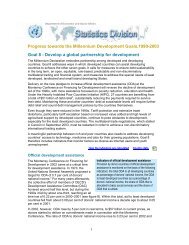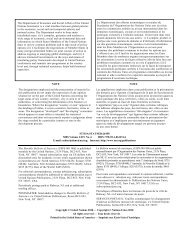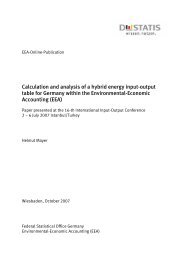- Page 3 and 4: •DEMOGRAPHIC YEARBOOKANNUAIRE DEM
- Page 6 and 7: TABLE OF CONTENTS (continued) - TAB
- Page 8 and 9: ForewordThe 1968 Demographic Yearbo
- Page 10 and 11: NOTE ON GEOGRAPHIC AREASThe designa
- Page 12 and 13: y blood or marriage who live togeth
- Page 14 and 15: with a household but taking their m
- Page 16 and 17: CHAPTER II. TECHNICAL NOTES ON THE
- Page 18 and 19: There are other more fundamental so
- Page 20 and 21: Italic type: The "Code for Current
- Page 22 and 23: Because this factor is so inextrica
- Page 24 and 25: It may be noted that some countries
- Page 26 and 27: to the Antarctic) has lost much of
- Page 30 and 31: etween 1955 and 1968. Included are
- Page 32 and 33: simply living apart and who mayor m
- Page 34 and 35: Estimates which are believed to be
- Page 36 and 37: Data believed to be unreliable (inc
- Page 38 and 39: Another factor which has a bearing
- Page 40 and 41: Coverage: A total of 77 countries a
- Page 42 and 43: and rurality as described in chapte
- Page 44 and 45: Data believed to be unreliable (inc
- Page 46 and 47: need to obtain statistics of divorc
- Page 48 and 49: Classification of duration is that
- Page 50 and 51: CHAPITRE I. DEFINITIONS ET CONCEPTS
- Page 52 and 53: qui prend ses repas et passe la plu
- Page 54 and 55: Espagne: Definition des Nations Uni
- Page 56 and 57: Royaume-Uni de Grande-Bretagne et d
- Page 58 and 59: pris soin d'apporter, autant que fa
- Page 60 and 61: I'appreciation de la qualite du chi
- Page 62 and 63: En revanche, si I'enregistrement n'
- Page 64 and 65: parce qu'ils ne sont pas prononces
- Page 66 and 67: 4. Visiteurs: c'est-a-dire non-resi
- Page 68 and 69: Portie: Les 24 regions que I'on a d
- Page 70 and 71: naturel, ainsi que I'esperance de v
- Page 72 and 73: population urbaine sont en caracter
- Page 74 and 75: La principale raison pour laquelle
- Page 76 and 77: Cependant, malgre leurs insuffisanc
- Page 78 and 79:
que Ie pourcentage des naissances i
- Page 80 and 81:
sur plusieurs annees n'ont guere de
- Page 82 and 83:
peut s'en faire une idee en consult
- Page 84 and 85:
dans Ie cas present, de la celebrat
- Page 86 and 87:
Insuffisances des donttees: Toutes
- Page 88 and 89:
Les categories employees ici pour I
- Page 90 and 91:
Tableau 37Le tableau 37 presente de
- Page 92 and 93:
Ainsi qu'il est recommande dans Ie
- Page 94 and 95:
WORLD SUMMARY2. Population by sex,
- Page 96 and 97:
---------_._---------WORLD SU M MAR
- Page 98 and 99:
WORLD SU M MARY2. Population by sex
- Page 100 and 101:
WORLD SUMMARY2. Population by sex,
- Page 102 and 103:
WORLD SU M MARY2. Population by sex
- Page 104 and 105:
---~---_.-WORLD SU M MARY2. Populat
- Page 106 and 107:
WORLD SU M MARY2. Population by sex
- Page 108 and 109:
WORLD SU M MARY2. Population by sex
- Page 110 and 111:
WORLD SUMMARY2. Population by sex,
- Page 112 and 113:
WORLD SUMMARY2. Population by sex,
- Page 114 and 115:
WORLD SUMMARY3. Vital statistics ra
- Page 116 and 117:
WORLD SUMMARY3. Vital statistics ra
- Page 118 and 119:
WORLD SU M MARY3. Vital statistics
- Page 120 and 121:
WORLD SUMMARY3. Vital statistics ra
- Page 122 and 123:
POPULATION4. Estimates of midyear p
- Page 124 and 125:
POPULATION4. Estimates of midyear p
- Page 126 and 127:
POPULATION4. Estimates of midyear p
- Page 128 and 129:
POPULATION4. Estimates of midyear p
- Page 130 and 131:
POPULATION5. Population by age and
- Page 132 and 133:
POPULATION5. Popu lation by age and
- Page 134 and 135:
POPULATION5. Population by age and
- Page 136 and 137:
POPULATION5. Population by age and
- Page 138 and 139:
POPULATION5. Population by age and
- Page 140 and 141:
POPULATION5. Population by age and
- Page 142 and 143:
POPULATION5. Population by age and
- Page 144 and 145:
POPULATION5. Population by age and
- Page 146 and 147:
POPULATION5. Population by age and
- Page 148 and 149:
POPULATION5. Population by age and
- Page 150 and 151:
POPULATION5. Population by age and
- Page 152 and 153:
POPULATION5. Population by age and
- Page 154 and 155:
POPULATION5. Population by age and
- Page 156 and 157:
POPULATION5. Population by age and
- Page 158 and 159:
POPULATION5. Population by age and
- Page 160 and 161:
w___ ••POPULATION5. Population
- Page 162 and 163:
POPULATION5. Population by age and
- Page 164 and 165:
POPULATION5. Population by age and
- Page 166 and 167:
POPULATION5. Population by age and
- Page 169 and 170:
POPULATION5, Population selon I'age
- Page 171 and 172:
POPULATION5. Population selon I'age
- Page 173 and 174:
163POPULATION5. Population selon I'
- Page 175 and 176:
POPULATION6. Population of capital
- Page 177 and 178:
POPULATION6. Population of capital
- Page 179 and 180:
POPULATION6. Population of capital
- Page 181 and 182:
POPULATION6. Population of capital
- Page 183 and 184:
POPULATION6. Population of capital
- Page 185 and 186:
POPULATION6. Population of capital
- Page 187 and 188:
POPULATION6. Population of capital
- Page 189 and 190:
POPULATION6. Population of capital
- Page 191 and 192:
POPULATION6. Population of capital
- Page 193 and 194:
POPULATION6. Population of capital
- Page 195 and 196:
-----------------------------------
- Page 197 and 198:
POPULATION6. Population of capital
- Page 199 and 200:
POPULATION6. Population of capital
- Page 201 and 202:
POPULATION7. Population selon I'eta
- Page 203 and 204:
POPULATION7, Population selon I'eta
- Page 205 and 206:
POPULATION7. Population selon I'eta
- Page 207 and 208:
POPULATION7. Population selon I'eta
- Page 209 and 210:
POPULATION7. Population selon I'eta
- Page 211 and 212:
POPULATION7. Population selon I'eta
- Page 213 and 214:
POPULATION7, Population selon I'eta
- Page 215 and 216:
POPULATION7. Population selon I'eta
- Page 217 and 218:
POPULATION7. Population selon retat
- Page 219 and 220:
POPULATION7. Population selon I'eta
- Page 221 and 222:
POPULATION7. Population selon I'eta
- Page 223 and 224:
POPULATION7. Population selon I'eta
- Page 225 and 226:
POPULATION7, Population selon I'eta
- Page 227 and 228:
POPULATION7. Population selon I'eta
- Page 229 and 230:
POPULATION7. Population selon retat
- Page 231 and 232:
POPULATION7. Population selon I'eta
- Page 233 and 234:
POPULATION7. Population selon I'eta
- Page 235 and 236:
POPULATION7. Population selon I'eta
- Page 237 and 238:
POPULATION7. Population selon I'eta
- Page 239 and 240:
POPULATION7. Population selon retat
- Page 241 and 242:
POPULATION7. Population selon I'eta
- Page 243 and 244:
7. Population selon I'etat matrimon
- Page 245 and 246:
POPULATION7. Population selon I'eta
- Page 247 and 248:
POPULATION7. Population selon I'eta
- Page 249 and 250:
POPULATION7, Population selon I'eta
- Page 251 and 252:
POPULATION7. Population selon I'eta
- Page 253 and 254:
14POPULATION7. Population selon I'e
- Page 255 and 256:
DivorcesDivorcesPOPULATION7. Popula
- Page 257 and 258:
POPULATION7. Population selon I'eta
- Page 259 and 260:
POPULATION7. Population selon I'eta
- Page 261 and 262:
POPULATION7. Population selon I'eta
- Page 263 and 264:
POPULATION7. Population selon I'eta
- Page 265 and 266:
POPULATION7. Population selon I'eta
- Page 267 and 268:
POPULATION7. Population selon I'eta
- Page 269 and 270:
POPULATION7, Population selon I'eta
- Page 271 and 272:
POPULATION7. Population selon I'eta
- Page 273 and 274:
POPULATION7. Population selon I'eta
- Page 275 and 276:
POPULATION7. Population selon I'eta
- Page 277 and 278:
POPULATION7. Population selon I'eta
- Page 279 and 280:
POPULATION7. Population selon I'eta
- Page 281 and 282:
POPULATION7. Population selon I'eta
- Page 283 and 284:
POPULATION7. Population selon I'eta
- Page 285 and 286:
POPULATION7. Population selon I'eta
- Page 287 and 288:
POPULATION7. Population by marital
- Page 289 and 290:
0. 160000POPULATION8. Female popula
- Page 291 and 292:
POPULATION8. Female population by a
- Page 293 and 294:
POPULATION8. Female population by a
- Page 295 and 296:
POPULATION8. Female population by a
- Page 297 and 298:
POPULATION9. Female economically ac
- Page 299 and 300:
POPULATION9. Female economically ac
- Page 301 and 302:
POPULATION9. Female economically ac
- Page 303 and 304:
POPULATION9. Female economically ac
- Page 305 and 306:
POPULATION9. Female economically ac
- Page 307 and 308:
POPULATION9. Female economically ac
- Page 309 and 310:
POPULATION9. Female economically ac
- Page 311 and 312:
POPULATION9. Female economically ac
- Page 313 and 314:
POPULATION9. Female economically ac
- Page 315 and 316:
POPULATION9. Female economically ac
- Page 317 and 318:
POPULATION9. Female economically ac
- Page 319 and 320:
POPULATION9. Female economically ac
- Page 321 and 322:
POPULATION10. Married female popula
- Page 323 and 324:
POPULATION10, Married female popula
- Page 325 and 326:
POPULATION11" Population by urban/r
- Page 327 and 328:
POPULATION11. Population by urban/r
- Page 329 and 330:
POPULATION11. Population by urban/r
- Page 331 and 332:
POPULATION11. Population by urban/r
- Page 333 and 334:
POPULATION12. Number, population an
- Page 335 and 336:
POPULATION12. Number, population an
- Page 337 and 338:
POPULATION12. Number, population an
- Page 339 and 340:
POPULATION12. Number, population an
- Page 341 and 342:
NATALITE13. Live births and crude l
- Page 343 and 344:
NATALITE13. Live births and crude l
- Page 345 and 346:
NATALITE13. Live births and crude l
- Page 347 and 348:
~~- -NATALITE13. Live births and cr
- Page 349 and 350:
NATALITE13, Live births and crude l
- Page 351 and 352:
NATALITE13. Live births and crude l
- Page 353 and 354:
NATALITE14. Live births by age of m
- Page 355 and 356:
NATALITE14. Live births by age of m
- Page 357 and 358:
NATALITE14. Live births by age of m
- Page 359 and 360:
NATALITE14. Live births by age of m
- Page 361 and 362:
NATALITE14. Live births by age of m
- Page 363 and 364:
NATALITE14, Live births by age of m
- Page 365 and 366:
Italics indicate data from civil re
- Page 367 and 368:
MORTALITE FCETALE15. Late foetal de
- Page 369 and 370:
MORTALITE FCE'fALE15. Late foetal d
- Page 372 and 373:
16. Foetal deaths and foetal death
- Page 374 and 375:
16. Foetal deaths and foetal deaths
- Page 376 and 377:
INFANT MORTALITY17. Infant deaths a
- Page 378 and 379:
INFANT MORTALITY17, Infant deaths a
- Page 380 and 381:
INFANT MORTALITY17. Infant deaths a
- Page 382 and 383:
INFANT MORTALITY17. Infant deaths a
- Page 384 and 385:
INFANT MORTALITY17. Infant deaths a
- Page 386 and 387:
GENERAL MORTALITY18. Deaths and cru
- Page 388 and 389:
GENERAL MORTALITY18. Deaths and cru
- Page 390 and 391:
GENERAL MORTALITY18. Deaths and cru
- Page 392 and 393:
GENERAL MORTALITY18. Deaths and cru
- Page 394 and 395:
GENERAL MORTALITY18. Deaths and cru
- Page 396 and 397:
--GENERAL MORTALITY19. Deaths by ag
- Page 398 and 399:
GENERAL MORTALITY19. Deaths by age,
- Page 400 and 401:
GENERAL MORTALITY19. Deaths by age,
- Page 402 and 403:
GENERAL MORTALITY19. Deaths by age,
- Page 404 and 405:
GENERAL MORTALITY19. Deaths by age,
- Page 406 and 407:
GENERAL MORTALITY19. Deaths by age,
- Page 408 and 409:
GENERAL MORTALITY19. Deaths by age,
- Page 410 and 411:
GENERAL MORTALITY19. Deaths by age,
- Page 412 and 413:
GENERAL MORTALITY19, Deaths by age,
- Page 414 and 415:
GENERAL MORTALITY19. Deaths by age,
- Page 416 and 417:
GENERAL MORTALITY19. Deaths by age,
- Page 418 and 419:
GENERAL MORTALITY19. Deaths by age,
- Page 420 and 421:
GENERAL MORTALITY19. Deaths by age,
- Page 422 and 423:
GENERAL MORTALITY19. Deaths by age,
- Page 424 and 425:
GENERAL MORTALITY19, Deaths by age,
- Page 426 and 427:
GENERAL MORTALITY20. Deaths and dea
- Page 428 and 429:
GENERAL MORTALITY20. Deaths and dea
- Page 430 and 431:
GENERAL MORTALITY20. Deaths and dea
- Page 432 and 433:
GENERAL MORTALITY20, Deaths and dea
- Page 434 and 435:
GENERAL MORTALITY20. Deaths and dea
- Page 436 and 437:
GENERAL MORTALITY20. Deaths and dea
- Page 438 and 439:
LIFE TABLES21. Expectation of life
- Page 440 and 441:
LIFE TABLES21. Expectation of life
- Page 442 and 443:
LIFE TABLES21. Expectation of life
- Page 444 and 445:
LIFE TABLES21. Expectation of life
- Page 446 and 447:
LIFE TABLES21. Expectation of life
- Page 448 and 449:
LIFE TABLES21. Expectation of life
- Page 450 and 451:
LIFE TABLES21. Expectation of life
- Page 452 and 453:
LIFE TABLES21. Expectation of life
- Page 454 and 455:
LIFE TABLES21. Expectation of life
- Page 456 and 457:
NUPTIAlITV22. Number of marriages:
- Page 458 and 459:
NUPTIALlTV22. Number of marriages (
- Page 460 and 461:
NUPTIALlTV22. Number of marriages (
- Page 462 and 463:
NUPTIALlTV22. Number of marriages (
- Page 464 and 465:
NUPTIALITV22, Number of marriages (
- Page 466 and 467:
NUPTIALlTV22. Number of marriages (
- Page 468 and 469:
NUPTIALlTV23. Crude marriage rates
- Page 470 and 471:
NUPTIALlTV23. Crude marriage rates
- Page 472 and 473:
NUPTIALITY23. Crude marriage rates
- Page 474 and 475:
NUPTIALITY23. Crude marriage rates
- Page 476 and 477:
NUPTIALITY23. Crude marriage rates
- Page 478 and 479:
NUPTIALITY23. Crude marriage rates
- Page 480 and 481:
NUPTIALlTV23. Crude marriage rates
- Page 482 and 483:
NUPTIALITY24. Marriages and crude m
- Page 484 and 485:
NUPTIALlTV25. Average annual marria
- Page 486 and 487:
NUPTIALITV25. Average annual marria
- Page 488 and 489:
NUPTIALlTV25, Average annual marria
- Page 490 and 491:
NUPTIALlTV25. Average annual marria
- Page 492 and 493:
NUPTIALITY26. Marriages by month of
- Page 494 and 495:
NUPTIALITV26, Marriages by month of
- Page 496 and 497:
NUPTIALlTV26. Marriages by month of
- Page 498 and 499:
NUPTIALITY26. Marriages by month of
- Page 500 and 501:
0. 81610. 7125•••••••
- Page 502 and 503:
NUPTIALITY26. Marriages by month of
- Page 504 and 505:
NUPTIALlTV26, Marriages by month of
- Page 506 and 507:
NUPTIAlITY26. Marriages by month of
- Page 508 and 509:
NUPTIALlTV27. Marriages by age of b
- Page 510 and 511:
NUPTIALITY27. Marriages by age (con
- Page 512 and 513:
NUPTIALlTV27. Marriages by age (con
- Page 514 and 515:
NUPTIALITY27. Marriages by age (con
- Page 516 and 517:
NUPTIALITY27. Marriages by age (con
- Page 518 and 519:
NUPTIALlTV27. Marriages by age (con
- Page 520 and 521:
1NUPTIALlTV27. Marriages by age (co
- Page 522 and 523:
~NUPTIALITY27. Marriages by age (co
- Page 524 and 525:
NUPTIALlTV27. Marriages by age (con
- Page 526 and 527:
NUPTIALITY27. Marriages by age (con
- Page 528 and 529:
NUPTIALITY27. Marriages by age (con
- Page 530 and 531:
NUPTIALlTV27. Marriages by age (con
- Page 532 and 533:
NUPTIALlTV27. Marriages by age (con
- Page 534 and 535:
NUPTIALlTV27. Marriages by age (con
- Page 536 and 537:
NUPTIALITY27. Marriages by age (con
- Page 538 and 539:
NUPTIALITY27. Marriages by age (con
- Page 540 and 541:
NUPTIALITY27. Marriages by age (con
- Page 542 and 543:
NUPTIALITY27. Marriages by age (con
- Page 544 and 545:
NUPTIALITY27. Marriages by age (con
- Page 546 and 547:
NUPTIALITY27. Marriages by age (con
- Page 548 and 549:
NUPTIALITY27. Marriages by age (con
- Page 550 and 551:
o. 3NUPTIALITV27. Marriages by age
- Page 552 and 553:
NUPTIALlTV27. Marriages by age (con
- Page 554 and 555:
NUPTIALITV27, Marriages by age (con
- Page 556 and 557:
NUPTIALlTV28. Marriage rates specif
- Page 558 and 559:
NUPTIALlTV28. Marriage rates specif
- Page 560 and 561:
NUPTIALITY28. Marriage rates specif
- Page 562 and 563:
NUPTIALITY28. Marriage rates specif
- Page 564 and 565:
NUPTIALITY28. Marriage rates specif
- Page 566 and 567:
NUPTIALITY28. Marriage rates specif
- Page 568 and 569:
NUPTIALITY28. Marriage rates specif
- Page 570 and 571:
NUPTIALlTV28. Marriage rates specif
- Page 572 and 573:
NUPTIALlTV29. Marriages cross-class
- Page 574 and 575:
NUPTIALITY29. Marriages cross-class
- Page 576 and 577:
-NUPTIALITYMariages selon rage: cla
- Page 578 and 579:
NUPTIALITYMariages selon I'age : cl
- Page 580 and 581:
NUPTIALITY29. Marriages cross-class
- Page 582 and 583:
NUPTIALITY29. Marriages cross-class
- Page 584 and 585:
NUPTIALITY29. Marriages cross-class
- Page 586 and 587:
NUPTIALlTV29, Marriages cross-class
- Page 588 and 589:
._--~---NUPTIALITY29. Marriages cro
- Page 590 and 591:
NUPTIALITV29. Marriages cross-class
- Page 592 and 593:
NUPTIALlTVMariages selon rage: clas
- Page 594 and 595:
NUPTIALlTV29. Marriages cross-class
- Page 596 and 597:
NUPTIALITY29. Marriages cross-class
- Page 598 and 599:
NUPTIALITY29. Marriages cross-class
- Page 600 and 601:
NUPTIALITY29. Marriages cross-class
- Page 602 and 603:
NUPTIALlTV29, Marriages cross-class
- Page 604 and 605:
NUPTIALlTV30. Marriages cross-class
- Page 606 and 607:
NUPTIALITY30. Marriages cross-class
- Page 608 and 609:
NUPTIALITY30. Marriages cross-class
- Page 610 and 611:
NUPTIALITY30. Marriages cross-class
- Page 612 and 613:
NUPTIALITY30. Marriages cross-class
- Page 614 and 615:
NUPTIALITY30. Marriages cross-class
- Page 616 and 617:
NUPTIALITY30, Marriages cross-class
- Page 618 and 619:
NUPTIALITY30. Marriages cross-class
- Page 620 and 621:
NUPTIALITY30. Marriages cross-class
- Page 622 and 623:
NUPTIALITY30. Marriages cross-class
- Page 624 and 625:
NUPTIALlTV30. Marriages cross-class
- Page 626 and 627:
NUPTIALITY30. Marriages cross-class
- Page 628 and 629:
NUPTIALITY30, Marriages cross-class
- Page 630 and 631:
NUPTIALITY30. Marriages cross-class
- Page 632 and 633:
30. Marriages cross-classified by p
- Page 634 and 635:
NUPTIALITY30. Marriages cross-class
- Page 636 and 637:
NUPTIALITV30. Marriages cross-class
- Page 638 and 639:
NUPTIALITY30. Marriages cross-class
- Page 640 and 641:
NUPTIALlTV30. Marriages cross-class
- Page 642 and 643:
NUPTIALlTV31. Marriages cross-class
- Page 644 and 645:
NUPTIALITY31. Marriages cross-class
- Page 646 and 647:
NUPTIALITY31, Marriages cross-class
- Page 648 and 649:
NUPTIALITY31. Marriages cross-class
- Page 650 and 651:
NUPTIALlTV31. Marriages cross-class
- Page 652 and 653:
NUPTIALlTV31. Marriages cross-class
- Page 654 and 655:
NUPTIALITV31. Marriages cross-class
- Page 656 and 657:
NUPTIALlTV31. Marriages cross-class
- Page 658 and 659:
NUPTIALlTV31. Marriages cross-class
- Page 660 and 661:
NUPTIALITY31. Marriages cross-class
- Page 662 and 663:
NUPTIALITV31. Marriages cross-class
- Page 664 and 665:
NUPTIALlTV31. Marriages cross-class
- Page 666 and 667:
NUPTIALlTV31. Marriages cross-class
- Page 668 and 669:
NUPTIALlTV31. Marriages cross-class
- Page 670 and 671:
NUPTIALITV31. Marriages cross-class
- Page 672:
NUPTIALlTV31. Marriages cross-class
- Page 675 and 676:
ANNULATION32. Annulations, nombres
- Page 677 and 678:
DIVORTIALITE33" Nombre de divorces
- Page 679 and 680:
-~._-------DIVORTIALITE33. Nombre d
- Page 681 and 682:
DIVORTIALITE33. Nombre de divorces
- Page 683 and 684:
DIVORTIALITE33, Nombre de divorces
- Page 685 and 686:
DIVORTIALITE33. Nombre de divorces
- Page 687 and 688:
34. Taux bruts de divortialite : 19
- Page 689 and 690:
DIVORTIALITE34. Taux bruts de divor
- Page 691 and 692:
DIVORTIALITE34. Taux bruts de divor
- Page 693 and 694:
DIVORTIALITE34. Taux bruts de divor
- Page 695 and 696:
DIVORTIALITE34. Taux bruts de divor
- Page 697 and 698:
DIVORTIAUTE35. Average annual divor
- Page 699 and 700:
DIVORTIALITE35. Average annual divo
- Page 701 and 702:
00000000••• 0 0 0 0 0 0 0•
- Page 703 and 704:
DIVORTIALITE36. Divorces selon I'ag
- Page 705 and 706:
DIVORTIALITE36. Divorces selon I'ag
- Page 707 and 708:
DIVORTIALITE36. Divorces selon I'ag
- Page 709 and 710:
DIVORTIALITE36. Divorces selon I'ag
- Page 711 and 712:
DIVORTIALITE36. Divorces selon I'ag
- Page 713 and 714:
DIVORTIALITE36. Divorces selon I'ag
- Page 715 and 716:
DIVORTIALITE36, Divorces selon I'ag
- Page 717 and 718:
DIVORTIALITE36. Divorces selon I'ag
- Page 719 and 720:
DIVORTIALITE36. Divorces selon I'ag
- Page 721 and 722:
DIVORTIALITE37. Taux de divortialit
- Page 723 and 724:
DIVORTIALITE37. Taux de divortialit
- Page 725 and 726:
DIVORTIALITE37. Taux de divortialit
- Page 727 and 728:
DIVORTIALITE38. Divorces cross-clas
- Page 729 and 730:
DIVORTIALITE38. Divorces cross-clas
- Page 731 and 732:
DIVORTIALITE38. Divorces cross-clas
- Page 733 and 734:
DIVORTIALITE38. Divorces cross-clas
- Page 735 and 736:
DIVORTIALITE38. Divorces cross-clas
- Page 737 and 738:
DIVORTIALITE38. Divorces cross-clas
- Page 739 and 740:
DIVORTIALITE38. Divorces cross-clas
- Page 741 and 742:
••••• 0' 11DIVORTIALITE38
- Page 743 and 744:
DIVORTIALITEDivorces selon Ie nombr
- Page 745 and 746:
DIVORTIALITE39. Divorces by number
- Page 747 and 748:
DIVORTIALITE39. Divorces by number
- Page 749 and 750:
DIVORTIALITE39. Divorces by number
- Page 751 and 752:
DIVORTIALITE39. Divorces by number
- Page 753 and 754:
DIVORTIALITE39. Divorces by number
- Page 755 and 756:
DIVORTIALITE40. Divorces by duratio
- Page 757 and 758:
DIVORTIALITE40. Divorces by duratio
- Page 759 and 760:
DIVORTIALITE40. Divorces by duratio
- Page 761 and 762:
~-_.--DIVORTIALITE40. Divorces by d
- Page 763 and 764:
DIVORTIALITE40. Divorces by duratio
- Page 765 and 766:
DIVORTIALITE40. Divorces by duratio
- Page 767 and 768:
DIVORTIALITEDivorces selon la duree
- Page 769 and 770:
1DIVORTIALITE41. Divorces selon la
- Page 771 and 772:
-DIVORTIALITE41. Divorces selon la
- Page 773 and 774:
DIVORTIALITE41. Divorces selon la d
- Page 775 and 776:
DIVORTIALITE41. Divorces selon la d
- Page 777 and 778:
DIVORTIAlITE41. Divorces selon la d
- Page 779 and 780:
DIVORTIALITE41. Divorces selon la d
- Page 781 and 782:
~~--DIVORTIALITE41. Divorces selon
- Page 783 and 784:
DIVORTIALITE41. Divorces selon la d
- Page 785 and 786:
DIVORTIALITE41. Divorces selon la d
- Page 787 and 788:
DIVORTIALITE41, Divorces selon la d
- Page 789 and 790:
DIVORTIALITE41. Divorces selon la d
- Page 791 and 792:
-- -------- ~-~-----DIVORTIALITE41.
- Page 793 and 794:
DIVORTIALITE41, Divorces selon la d
- Page 795 and 796:
MIGRATION INTERNATIONALE42. Arrival
- Page 797 and 798:
MIGRATION INTERNATIONALE42, Arrival
- Page 799 and 800:
MIGRATION INTERNATIONALE42. Arrival
- Page 801 and 802:
MIGRATION INTERNATIONALE42. Arrival
- Page 803 and 804:
MIGRATION INTERNATIONALE43. Departu
- Page 805 and 806:
MIGRATION INTERNATIONALE43. Departu
- Page 807 and 808:
MIGRATION INTERNATIONALE43. Departu
- Page 809:
MIGRATION INTERNATIONALE43. Departu
- Page 812 and 813:
INDEXSubject-matter index (continue
- Page 814 and 815:
INDEXSubject-matter index (continue
- Page 816 and 817:
INDEXSubject-matter index (continue
- Page 818 and 819:
INDEXSubject-matter index (continue
- Page 820 and 821:
INDEXIndex par sujet (suite)[Voir n
- Page 822 and 823:
INDEXIndex par sujet (suite)[Voir n
- Page 824 and 825:
INDEXIndex par sujet (suite)[Voir n
- Page 826 and 827:
INDEXIndex par sujet (suite)[Voir n
- Page 828 and 829:
INDEXIndex par sujet (suite)[Voir n
- Page 830:
STATISTICAL PAPERS (continued)Serie












